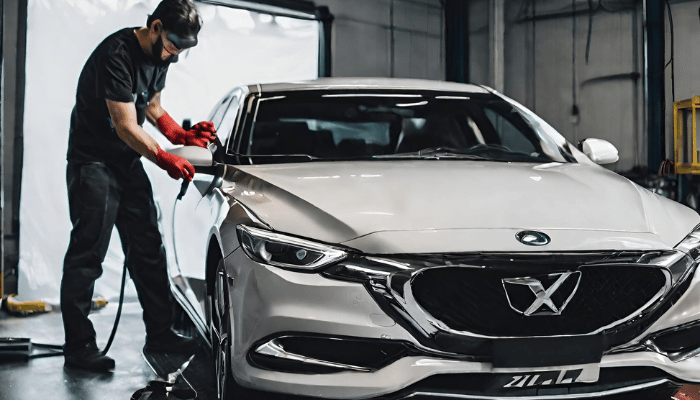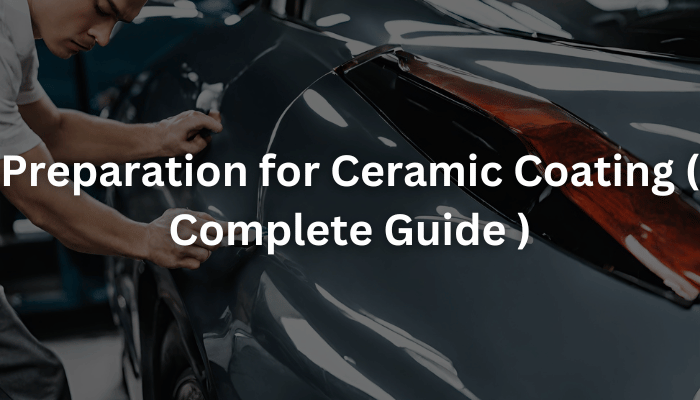Preparation for Ceramic Coating ( Complete Guide )
Introduction
As a new product in the realm of automotive care, ceramic coating improves the beauty of cars and builds a strong coating against different elements. Nevertheless, the preparation process holds the key to the full exploitation of ceramic coating.
Preparation is one of the most important phases in ceramic coating and the effectiveness and durability of the coating depend on this step. This process is a detailed process of cleaning, sanitizing, and polishing the surface to achieve effective adhesion of the coating. Although this process may appear overwhelming, it can be easily understood and implemented in the right direction.
In this blog, we shall unravel the preparation for ceramic coating. Our goal is to provide an all-inclusive, easy-to-follow guide for all people, whether they are new to ceramic coatings or not. Therefore, whether you are a professional detailer or a car enthusiast who wants to try his/her hand at ceramic applications, this blog will walk you through your way to mastering the art of preparation.
What is Ceramic Coating?
This is the latest product of detailing, nano-ceramic coating, used for protecting the interior and exterior of the car. Ceramic coating, however, bonds on a molecular level with the vehicle’s paintwork making it better with the external hazards and wears.
The main element of ceramic coating is silicon dioxide (SiO2), which is derived from natural substances, such as quartz and sand. It gives a semi-eternal adhesion with the car’s surface creating a tough barrier. This layer is a hydrophobic surface, transparent and extremely thin, repelling water as well as dirt and other contaminants.
Ceramic coating is one of the longest-lasting benefits. A ceramic coating lasts for years, as opposed to waxing. This results in a high-gloss finish that increases the beauty of the car and also protects the paintwork against UV damage, chemical stains, and light scratches.
Nevertheless, the performance of this technology depends on the preparation stage. Preparation is important to enabling the coating to bond correctly to the surface, thereby optimizing its protective functions. This preparation will be outlined in the subsequent sections.
Note, that ceramic coating is more than a mere protection as it’s a preservation of your car’s look and cost. Therefore, let us examine how to get your car ready for this revolutionary treatment!

The Importance of Preparation
However, the preparation process is one of the most essential stages of an application. This is not just a prelude, but an indicator of how long and how successful the ceramic coating will be.
Preparation is done to provide the best substrate on which the ceramic coating would stick. This entails cleaning, decontamination, and polishing the surface of the vehicle to ensure that it is dirt-free, dust-free, and grime-free. Any defects or dirt on the surface can result in substandard results and a shorter lifespan for the coating.
In addition, a pre-treated surface makes it easy for the ceramic coating to exhibit its full capabilities. It improves the hydrophobicity, gloss, and protective power of the coating.
Preparation, in a nutshell, is what builds this ceramic coating foundation. Even the best ceramic coating can fail to function if the surface is not prepared properly. Given that, it’s worth investing time and effort in the preparation process to achieve a lasting and effective ceramic coating application.
In the following section, we will take you through a preparatory process of steps to prepare your car for ceramic coating. Remember, the best preparation makes perfect finishing!
Step-by-Step Preparation Guide
Preparation involves several steps toward ceramic coating. All this is important to execute carefully. Here’s a detailed guide:
1. Cleaning
The first step in the preparation process is cleaning. The car has to be washed from the top down with the dust, dirt, or grime that has accumulated loosely removed. Gently wash it with a quality car wash soap and a soft wash mitt. Clean it and dry it by hand using microfiber. However, the process is aimed at eliminating all contaminants that can block the ceramic coat application.
2. Decontamination
Then the process of sanitization is done. In this stage, one utilizes a clay bar or a clay mitt, for removing any contaminants left in the paint after washing. Run the clay bar over the vehicle surface, lightly, to remove any remaining contaminants. Wash the vehicle thoroughly and dry it very thoroughly after claying.
3. Polishing
After the surface is cleared and clean from contamination, it’s the polishing time. Polishing helps in taking off minor scratches, swirl marks, and other blemishes from the paint surface. For this, a dual-action polisher and the appropriate polishing compound should be used. Wipe off all residues using a clean microfiber cloth and work in small sections.
4. Pre-Coating Prep
Pre-coating prep is a stage before painting. Precoating entails wiping IPA (Isopropyl Alcohol) solution or prep spray over the surface. This assures that there won’t be any traces of oils or other polishing residues that remain on the surface. The coating must adhere to a clean surface.
It is important to note that every preparation step is critical. Skipping any stage or rushing through the process may render the ceramic coating ineffective and short-lived. Therefore, move slowly and be diligent in executing each task.

Conclusion
We have already discussed the preparation process to be the most significant stage of ceramic coating application. It is not just another step in the process, but the bedrock upon which the success of ceramic coating application depends.
Each stage of the preparation process is important for the ceramic coating to stick properly to the surface to enhance its protective functions and durability.
The ceramic coating would be able to demonstrate its hydrophobic properties, glossiness, as well as protection abilities if the surface was adequately prepared. Thus, it’s vital to spend effort and time in the preparation process so that the ceramic coating application will be successful and long-lasting.
We hope this guide has given you a sufficient explanation of the importance of preparation and how well you should prepare your vehicle for ceramic coating. Having this information now, you’re equipped to begin your ceramic coating voyage.
Ceramic coating is more than just a shield, it’s protection to keep your car looking new and retain its value. Therefore, slow down, follow the procedure, and prepare your car to receive the best shield that ceramic coating offers.
FAQs regarding ( Preparation before Ceramic Coating )
1. What is ceramic coating?
Ceramic coating is a bonding layer with your vehicle’s paint on a molecular basis that gives you durability, a protective barrier from damage, and high luster.
2. Why should one prepare for ceramic coating?
Proper preparation makes the ceramic coating stick better onto the surface of your vehicle, hence, optimizing its protective and longevity qualities. This includes removal of soil, decontamination, and polish.
3. What is my car preparation for the coat?
First, clean your car with water to remove the dislodged dust, dirt, and grime. Use a high-quality washing soap and soft wash mitt to gently clean the surface.
4. The importance of decontamination in ceramic coating preparation?
Decontamination is achieved by the use of a clay bar or a clay mitt, which are good for any remaining wash residue.
5. How should I clean my vehicle for the preparation of ceramic coating?
Dual-action polisher combined with an appropriate polishing compound helps to get rid of minor scratches, swirl marks, and other surface imperfections on the paint surface.
6. Pre-coating prep in ceramic coating preparation.
Either an ISO (Isopropyl Alcohol) solution or a pre-coat prep spray is required in a pre-coat prep. This ensures that the surface is completely clean of any oils and polishing remnants.
7. For how long will the ceramic coating stay?
This ceramic coating can work for years by applying it well. However, the durability of the coating greatly depends on the preparation and regular maintenance.
